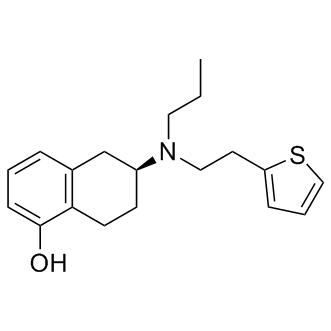
Rotigotine
CAS No. 99755-59-6
Rotigotine( N-0923 | SPM 962 )
Catalog No. M16916 CAS No. 99755-59-6
A non-selective agonist of the dopamine D3 receptor (Ki=0.71 nM); has 10-fold selectivity for the D3 receptor over the D2, D4, and D5 receptors and 100-fold selectivity for the D3 receptor over the D1 receptor.
Purity : >98% (HPLC)
 COA
COA
 Datasheet
Datasheet
 HNMR
HNMR
 HPLC
HPLC
 MSDS
MSDS
 Handing Instructions
Handing Instructions
| Size | Price / USD | Stock | Quantity |
| 5MG | 43 | In Stock |


|
| 10MG | 64 | In Stock |


|
| 25MG | 133 | In Stock |


|
| 50MG | 241 | In Stock |


|
| 100MG | 357 | In Stock |


|
| 200MG | 524 | In Stock |


|
| 500MG | 822 | In Stock |


|
| 1G | Get Quote | In Stock |


|
Biological Information
-
Product NameRotigotine
-
NoteResearch use only, not for human use.
-
Brief DescriptionA non-selective agonist of the dopamine D3 receptor (Ki=0.71 nM); has 10-fold selectivity for the D3 receptor over the D2, D4, and D5 receptors and 100-fold selectivity for the D3 receptor over the D1 receptor.
-
DescriptionA non-selective agonist of the dopamine D3 receptor (Ki=0.71 nM); has 10-fold selectivity for the D3 receptor over the D2, D4, and D5 receptors and 100-fold selectivity for the D3 receptor over the D1 receptor; behaves as a full agonist of D1, D2, and D3 with similar potencies (EC50) in functional assay; also demonstrates significant affinity at α-adrenergic (α2B, Ki=27 nM) and serotonin receptors (5-HT1A Ki=30 nM); significantly attenuates MPTP-induced acute cell degeneration in mouse model.Parkinson's Disease Approved(In Vitro):Rotigotine (0.01-10 μM) slightly protects dopaminergic neurons against MPP+ toxicity dopamine, protects dopaminergic neurons against rotenone-induced cell death and significantly inhibits ROS production by rotenone.(In Vivo):Rotigotine (0.1-5 mg/kg; i.h.; for 14 days; male Sprague–Dawley rats) has antidepressant effect.
-
In VitroRotigotine (0.01-10 μM) slightly protects dopaminergic neurons against MPP+ toxicity dopamine, protects dopaminergic neurons against rotenone-induced cell death and significantly inhibits ROS production by rotenone.
-
In VivoRotigotine (0.1-5 mg/kg; i.h.; for 14 days; male Sprague–Dawley rats) has antidepressant effect. Animal Model:Male Sprague–Dawley rats Dosage:0.1, 0.5, 1, and 5 mg/kg Administration:Subcutaneous injection; for 14 days.Result:Had antidepressant effect at a dose of 1 mg/kg or less.
-
SynonymsN-0923 | SPM 962
-
PathwayGPCR/G Protein
-
TargetDopamine Receptor
-
RecptorD2|D3
-
Research AreaNeurological Disease
-
IndicationParkinson Disease
Chemical Information
-
CAS Number99755-59-6
-
Formula Weight315.4729
-
Molecular FormulaC19H25NOS
-
Purity>98% (HPLC)
-
Solubility10 mM in DMSO
-
SMILESCCCN(CCC1=CC=CS1)C2CCC3=C(C2)C=CC=C3O
-
Chemical Name1-Naphthalenol, 5,6,7,8-tetrahydro-6-[propyl[2-(2-thienyl)ethyl]amino]-, (6S)-
Shipping & Storage Information
-
Storage(-20℃)
-
ShippingWith Ice Pack
-
Stability≥ 2 years
Reference



-
ONC206
ONC206 is an analogue of TRAIL inducer ONC201 and is a selective antagonist of the D2-like dopamine receptors (DRD2/3/4) at nanomolar concentrations. ONC206 also has broad-spectrum anti-tumor activity. ONC206 (Oncoceutics) is an imipiridone with nanomolar potency and analogue of ONC201, a selective dopamine receptor D2 (DRD2) antagonist currently being investigated in phase II clinical trials for serous endometrial cancer (SEC).??
-
Nomifensine
Nomifensine is a norepinephrine-dopamine reuptake inhibitor that prevents dopamine reuptake into synaptosomes.
-
FAUC 346
FAUC 346 is a highly selective D3 partial agonist with EC50 of 1.5 nM, FAUC 346 with an inhibitory effect on cocaine-seeking behavior.



 Cart
Cart
 sales@molnova.com
sales@molnova.com


